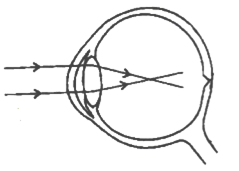 Short Answer Type
Short Answer TypeGiven in the box below are a set of l4 biological terms. Of these, 12 can be paired into 6 matching pairs. Out of the six pairs. one has been done for you as an example.
Example: endosmosis - Turgid cell.
Identify the remaining five matching pairs:
|
Cushing's syndrome, Turgid cell, Iris, Free of rod and cone cells, Colour of eyes, Hypoglycemia. Active transport, Acrosome. Addison's disease. |
State the main function of the following:
(i) Lymphocytes of blood
(ii) Leydig cells
(iii) Guard cells
(iv) Eustachian tube
(v) Corpus luteum
Give scientific reasons for the following statements;
Colour blindness is more common in men than in women.
Give scientific reasons for the following statements;
lnjury to medulla oblongata leads to death.
Give scientific reasons for the following statements;
When an ovum gets fertilised, menstrual cycle stops temporarily in a 'woman'
Give scientific reasons for the following statements;
Mature erythrocytes in humans lack nucleus and mitochondria.
Give scientific reasons for the following statements;
Blood flows in arteries in spurts and is under pressure.
The walls of the arteries are highly muscular and the lumen present in arteries is very narrow. The walls of the artery expand and contract alternatively as they are highly muscular and elastic in nature. The blood flowing in arteries carries the blood with thee force applied by heart while pushing the blood in to arteries. Due to this the blood flowing in arteries is at high pressure and also flow in jerky fashion.
 Long Answer Type
Long Answer TypeGiven below is a diagram depicting a defect of the human eye, study the same and answer the questions that follow:
(i) Name the defect shown in the diagram.
(ii) What are the two possible reasons that cause this defect?
(iii) Name the type of lens used to correct this defect.
(iv) With the help of a diagram show how the defect shown above is rectified using a suitable lens.
The figure given below is a diagrammatic representation of a part of the cross section of the root in the root hair zone. Study the same and then answer the questions that follow:

(i) Name the parts indicated by the guidelines 1 to 4.
(ii) Which is the process that enables the passage of water from the soil into, the root hair?
(iii) Name the pressure that is responsible for the movement of water in the direction indicated by the arrows. Define it.
(iv) Due to an excess of this pressure sometimes drops of water are found along the leaf margins of some plants especially in the early mornings. What is the phenomenon called?
(v) Draw a well labelled diagram of the root hair cell as it would appear if an excess of fertiliser is added to the soil close to it.
